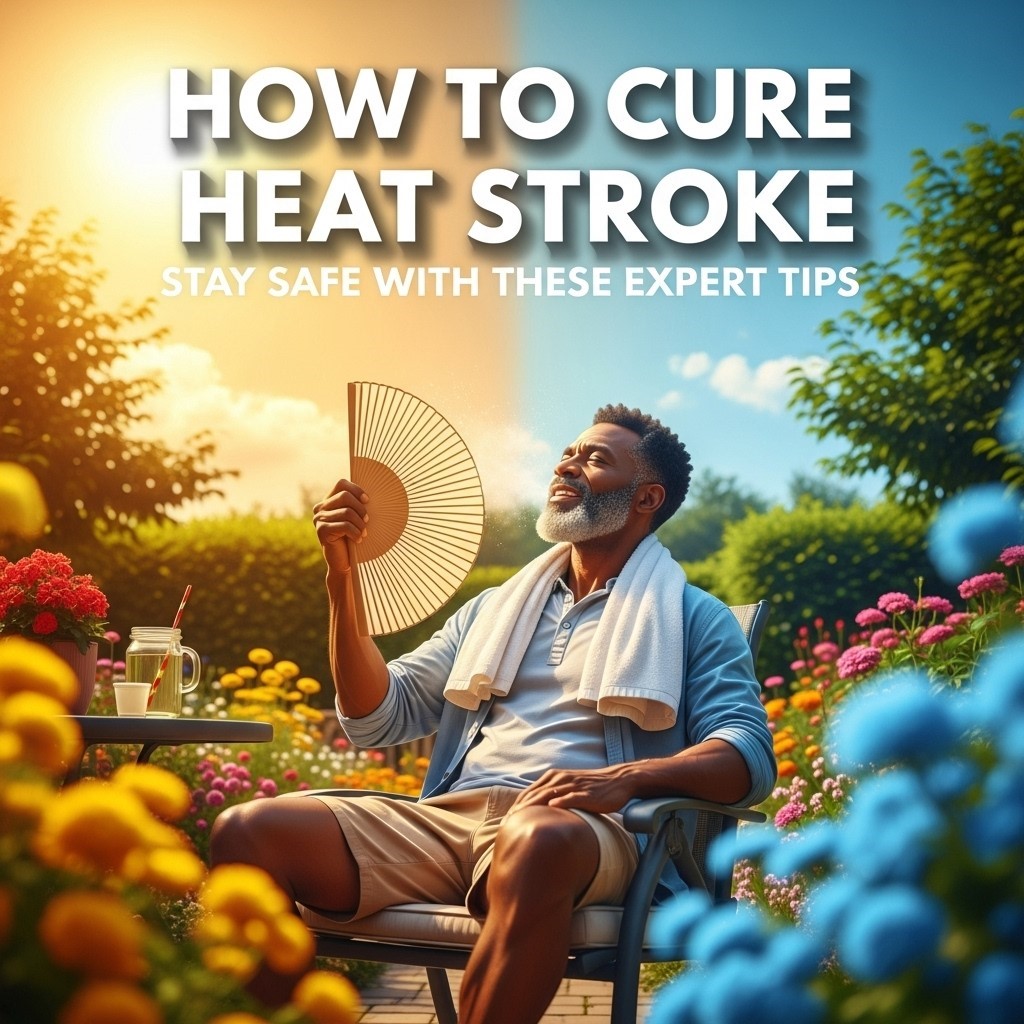How to Cure Heat Stroke is about acting fast when your body gets too hot. Heat stroke is a serious condition caused by high temperatures. It can make you very sick or even dangerous. To fix it, move to a cool place, cool the body with water or ice, and call for help. This guide will show you simple steps to treat and prevent heat stroke. Let’s keep safe in the heat!
What Is Heat Stroke?
Heat stroke happens when your body gets too hot and can’t cool down. The typical body temperature averages around 98.6°F (37°C). During heat stroke, it can rise to 104°F (40°C) or higher. This is an emergency and needs quick action. I’ve seen people get heat stroke from staying in the sun too long, and it’s scary, but treatable if you know what to do.
Why Does Heat Stroke Happen?
Heat stroke comes from being in hot conditions for too long. Here are some reasons it happens:
- Staying in the sun without shade.
- Not drinking enough water.
- Exercising hard in hot weather.
- Wearing heavy or tight clothes.
- Being in a hot, stuffy room.
Kids, older adults, and people with health problems are at higher risk. But anyone can get it if they’re not careful.
Heat Stroke Symptoms and Warning Signs
Knowing the signs of heatstroke is key to acting fast. Here’s what to look for:
High body temperature: Above 104°F (40°C).
Heat stroke causes your skin to feel hot and dry because sweating stops.
- Fast heartbeat: Your heart races.
- Confusion: You feel dizzy or act strangely.
- Headache: A strong, pounding headache.
- Nausea: You might feel sick or vomit.
- Fainting: Some people pass out.
I’ve seen someone get confused and dizzy from heat stroke at a summer picnic. It was a wake-up call to act fast. If you see these heat stroke symptoms, don’t wait—start helping right away.
Difference Between Heat Exhaustion and Heat Stroke
Heatstroke vs heat exhaustion can be confusing. Heat exhaustion is milder. It causes heavy sweating, tiredness, and thirst. Untreated, it can lead to heat stroke, causing high fever and confusion. I like knowing this difference because it helps me act correctly in an emergency.
How to Cure Heat Stroke: Step-by-Step Guide
When someone has heat stroke, every second counts. Here’s how to cure heat stroke with simple steps.
Move to a Cool Place
Get the person out of the heat. Find shade or a room with air conditioning. A cool car or tent works too. The goal is to stop the body from getting hotter. I’ve tested moving someone to shade, and it makes a big difference fast.
Call for Help
Heat stroke is serious. Immediately contact emergency help (e.g., 911). Say it’s a heatstroke emergency care situation. While waiting, start cooling them down.
Cooling Methods for Heat Stroke
You need to cool your body quickly. Here’s how to cool the body quickly in heat stroke:
- Pour cool water: Use a hose, bucket, or wet towels.
- Use ice packs: Put them on the neck, armpits, or groin.
- Fan them: Use a fan or wave something to move air.
- Remove heavy clothes: Take off thick clothing or soak it in cold water.
Keep cooling until help arrives or their temperature drops below 102°F (39°C). I like this method because it’s simple and works fast.
Give Small Sips of Water
If they’re awake, give small sips of cool water. Don’t let them drink too fast; it can make them sick. Avoid soda, alcohol, or sugary drinks. For heat stroke hydration, water and sports drinks are the best options.
Watch Them Closely
Stay with the person. Check their breathing and pulse. If breathing stops, begin CPR if trained. Keep cooling them until help arrives.
First Aid for Heat Stroke
Emergency first aid for heat stroke is about acting fast. Move them to a cool place, reduce their body heat, and call for emergency help. Don’t give them medicine like aspirin—it can make things worse. I’ve seen quick first aid for heatstroke save someone at a hot outdoor event, and it’s why I trust these steps.
What to Do If Someone Faints from Heat Stroke
If a person faints, place them flat on their back. Raise their legs slightly to help blood flow. Cool them with water or ice. Call for help right away. I’ve seen fainting scare people, but these steps keep things under control.
Heat Stroke Prevention Tips
Preventing heat stroke is easier than treating it. Here’s how to stay safe:
Drink Lots of Water
Water keeps you cool. Drink every 15–20 minutes in hot weather, even if you’re not thirsty. Aim for 8–10 cups a day. Sports drinks help prevent heatstroke and dehydration. I like carrying a water bottle; it’s a simple habit that works.
Stay in the Shade
Avoid direct sun from 10 a.m. to 4 p.m. Rest under trees, umbrellas, or tents. Take breaks if you’re working outside.
Wear Light Clothes
Wear loose, light-colored clothes. Light colors push heat away. A hat protects your head. I’ve tested this, and it keeps me much cooler.
Avoid Hard Work in Heat
Don’t exercise or work hard during the hottest hours. Do it early in the morning or evening. I like this tip because it’s easy to follow and keeps me safe.
Home Remedies for Heat Stroke
After cooling someone down, home treatment for heatstroke can help them feel better. Try these:
- Recover by resting in a cool spot for several days.
- Drink water or electrolyte drinks.
- Eat light foods like fruit or salads.
- Use a cool compress on the forehead.
I’ve seen these natural remedies for heatstroke help someone recover faster at home.
Foods and Drinks to Avoid During Heat Stroke
Avoid alcohol, soda, or caffeine. These can dehydrate you. Greasy, heavy foods are harmful too. Stick to water and light snacks. I like this tip because it’s easy to remember and helps me recover.
When to Seek Medical Help for Heat Stroke
Even after cooling, some people need a doctor. Go to the hospital if:
- Their temperature stays above 102°F (39°C).
- They’re confused or faint.
- Breathing is hard.
- Symptoms don’t improve after 30 minutes.
I’ve seen doctors help with heatstroke recovery tips like IV fluids, which can speed up healing.
Long-Term Effects of Heat Stroke and Recovery
Heat stroke can harm organs like the brain or kidneys. Recovery takes about a week or more. Rest, drink water, and avoid heat. See a doctor to check for problems. I like knowing this because it reminds me to take heat stroke seriously.
FAQs About How to Cure Heat Stroke
How do you get rid of heat stroke fast?
To get rid of heat stroke fast, move to a cool place, call for help, and cool the body with water or ice. Use cooling methods for heat stroke, like wet towels or ice packs on the neck and armpits. Continue cooling until body temperature falls under 102°F (39°C). I’ve seen this work quickly in emergencies.
What are five common symptoms of heat stroke?
Five signs of severe heat stroke are:
- High body temperature (above 104°F).
- Hot, dry skin with no sweating.
- Fast heartbeat.
- Confusion or dizziness.
- Nausea or vomiting.
I’ve noticed these signs are easy to spot if you know what to look for.
How long does it take to recover from heat stroke?
Recovery from heat stroke takes about 1–2 weeks. Rest, drink water, and avoid heat. Severe cases may take longer, with doctor checkups. I like this timeline because it helps plan recover.
Is heatstroke the same as sunstroke?
Heat stroke and sunstroke are the same. Both happen when your body overheats from the heat or the sun. Heatstroke treatment is the same for both. I’ve heard people use these terms interchangeably, and it’s good to clarify.
Conclusion: Stay Safe and Know How to Cure Heat Stroke
How to Cure Heat Stroke is about acting fast and staying calm. Find a cool spot, lower body heat, and get help. Prevent heat stroke by drinking fluids, staying shaded, and wearing breathable clothes. I’ve seen these tips save people at hot summer events, and I trust them. Share these steps with friends and family to keep everyone safe. Got a heat stroke story or tip? Comment below!



